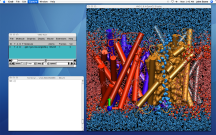VMD 1.8.4
Major features included in VMD 1.8.4:
VMD 1.8.4 is the first version ported to MacOS X running on Intel x86 processors, Linux running on Intel Itanium processors, and AIX 5.x on 32-bit and 64-bit POWER processors.
Structure building and modeling tasks are easier than before with the introduction of the new AutoPSF, Molefacture, Mutator, and Paratool plugins, which automate common modeling tasks and integrate closely with the existing Autoionize, Membrane, PSFGen, and Solvate plugins.
The new NAMD Energy, NAMD Plot, Multiplot, RMSD Trajectory Tool, and VolMap, plugins assist with several common simulation trajectory analysis tasks. Several new simulation preparation tools ease the task of setting up simulations in APBS, AutoIMD, NAMD, and for QM jobs used in parameterization.
Newly developed BioCoRE collaboration plugins make it much easier to collaborate with other researchers online and exchange VMD saved states. With the new BioCoRE plugins, it is no longer necessary to start VMD from within a BioCoRE session in order to take advantage of these features. Once connected to BioCORE with the new plugins, a user can write and use their own scripts to access the shared filesystem and lab notebook, run simulation jobs on remote supercomputers, and use other features via the BioCoRE API.
VMD 1.8.4 includes many core enhancements including support for selecting and displaying PDB files containing multiple conformations, improved atomic mass and radius guessing from files where atomic element data is present, improved handling of non-biological structures containing hundreds of thousands of atoms in a single "residue", and improved handling of unusual protein structures.
Support for working with very large simulation trajectories has been significantly improved. A new NetCDF plugin supports reading of AMBER 9 NetCDF trajectories, and MMTK NetCDF structures and trajectories. The Windows version of VMD can now read DCD trajectories larger than 2GB through the use of native Windows I/O calls. CHARMM format DCD files produced by -i8 64-bit CHARMM binaries can now be loaded on all platforms.
Short list of other popular features and improvements in VMD 1.8.4:
- Support for loading Situs volumetric map files
- Support for loading UHBD volumetric map files
- Updated GAMESS plugin supports log files from the newest versions
- Updated Mol2 plugin now writes mol2 files that are compatible with DOCK
- New coarse grained "Beads" representation for display of huge structures
- New "Shaded Points" Isosurface rendering mode for fast display of large volumetric isosurfaces
- New VolMap tool calculates volumetric density, distance, occupancy, and mask maps from atomic coordinates and trajectories (time averaged)
- Improved "Volume" coloring method works with graphics boards that have less texture memory, for use with electrostatic potential maps, and other volumetric datasets, requires OpenGL 1.2 3-D texture mapping.
- Improved Solvate plugin now optionally rotates solute structures to minimize solvent volume and atom count
- New "measure" commands for calculating per-atom RMS fluctuations and average positions over trajectories, and summing of mass, charge, and other per-atom properties efficiently.
- 16 new or improved file reader plugins provide support various structure and trajectory formats, and greatly improved I/O performance for large trajectories.
- New built-in text viewer plugin provides a simple text editor which can be used within VMD itself.
- New color scale bar plugin assists with creating color scale labels within VMD.
- Updated APBS plugin supports the latest APBS 0.4.x versions.
- The Movie Maker plugin now generates movies in more formats, accepts time-based movie lengths rather than frames, and provides a user-extensible interface for movie generation based on user-defined frame callbacks.
- New "volN" atom selection keyword allows selection of atoms that correspond to specified voxel values for volumetric datasets
- New "altloc" atom selection keyword allows selections on PDB structures that contain multiple conformations. VMD doesn't generate bonds between conformations with different identifiers.
- New 'atomicnumber' and 'element' data fields are provided when structures are loaded from files containing unambiguous atomic element information. These new keywords can be used in atom selections.
- New "Element" coloring mode will color atoms by their atomic element type, when available.
- When atomic element information is available, VMD uses a periodic table lookup to determine atomic mass and VDW radii, if not it will guess using the old atom name recognizer heuristic.
- New "measure avpos" command for measuring per-atom average positions over a trajectory
- New "measure rmsf" command for measuring per-atom RMS fluctuations over a trajectory
- New "measure sumweights" sum up mass, charge, or one of the other scalar floating point values efficiently.




